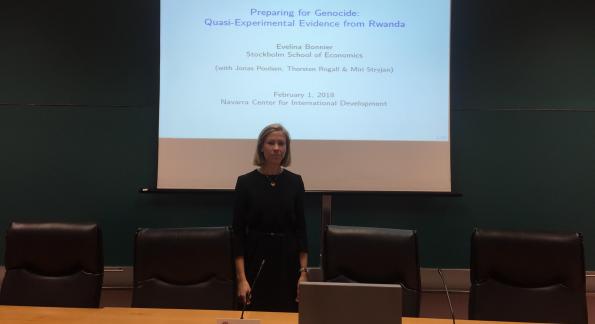
From April 7 to mid-July 1994, humanity was witness to one of the worst acts of barbarism in history: the Rwandan Genocide. This atrocious event was carried out, not only by the army, but also by butchers, herdsmen, bakers, businessmen, bus drivers, farmers, etc. To this day, a question remains: what makes 430,000 civilians grab all sorts of items as weapons to kill nearly one million of their fellow countrymen in just one hundred days? To understand this one must look back to the years and months prior to it and wonder how those in power were able to instill such hatred towards the Tutsi population.
Evelina Bonnier, a PhD candidate from the Stockholm School of Economics, aims to answer this question on her paper titled: Preparing for Genocide: Quasi-Experimental Evidence from Rwanda, which he presented at the University of Navarra on February 1st. Her investigation analyzes the potential role in fueling violence against the Tutsi population of a mandatory community program whose supposed objective was to ensure community work and political participation.
Results suggest that Umuganda meetings contributed to an overall acceptance of the idea of genocide in two ways: First, it facilitated top-down pressure as Hutu officials could spread their racist and violent views towards the population. “We find supportive evidence of Umuganda contributing to the mobilization through coordination and diffusion of political propaganda and information”, Bonnier argued. Furthermore, the gatherings also fostered bottom-up pressure, as positive reaction to remarks inciting violence against the Tutsi by other members of a village served to potentiate radical views.
There is no clear data on the number of people attending those large-scale mobilizations and the number of meetings. To investigate the effect that Umuganda had on the mobilization of Hutu civilians for genocide, Bonnier traces the relationship between the civilian participation in genocide violence and heavy rain on Saturdays. The latter is a clever way to make up for unavailable data and serves as a proxy to cancelled Umuganda meetings. Results show that fewer meetings resulted in lower civilian participation in the genocide.
“The idea is simple: we expect the meetings to be less enjoyable when it rains, and canceled altogether under heavy rains”, explained Bonnier. Since meetings took place on Saturdays, the study focuses only on the number of Saturdays with heavy rainfall during the 3.5 year period preceding the genocide (from October 1990, the outbreak of the civil war, to March 1994, the eve of the genocide). “[A] one standard deviation increase in the number of rainy Saturdays lead to a 17 percent decrease in the civilian participation rate”, posited Bonnier. This study contributes to recent literature on rainfall effect on conflict, but also has the intention of generating debate around the potential effects of public gatherings. “Community meetings have recently been promoted as strongly beneficial to development by many NGOs”, she said. “However, social clubs in Germany post-World War I facilitated recruitment into the Nazi party. We want to highlight this socially destructive potential of community meetings. “With our investigation, we show that the Rwandan Genocide was carefully prepared by the political elites”, Bonnier concluded.






